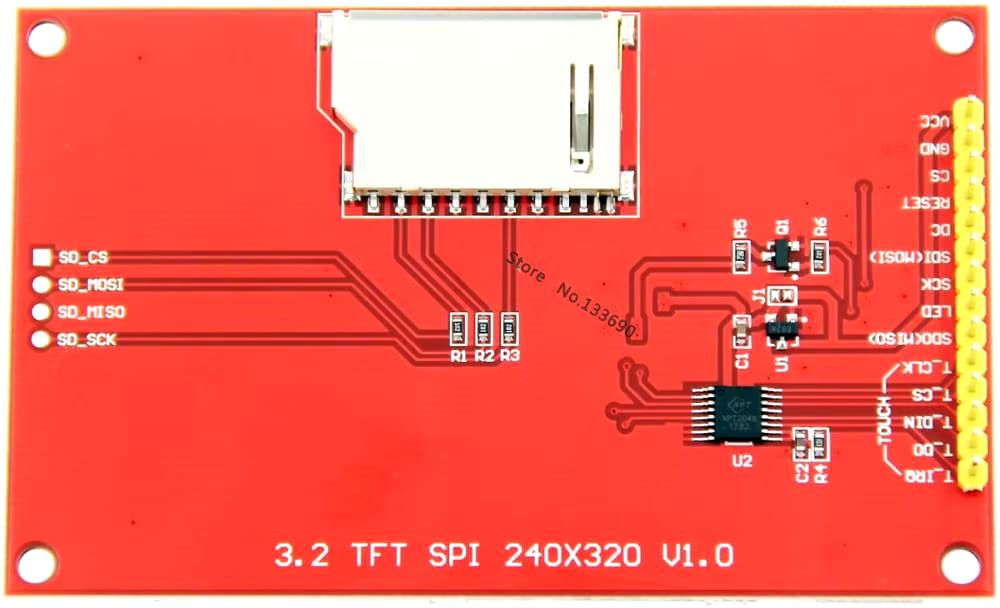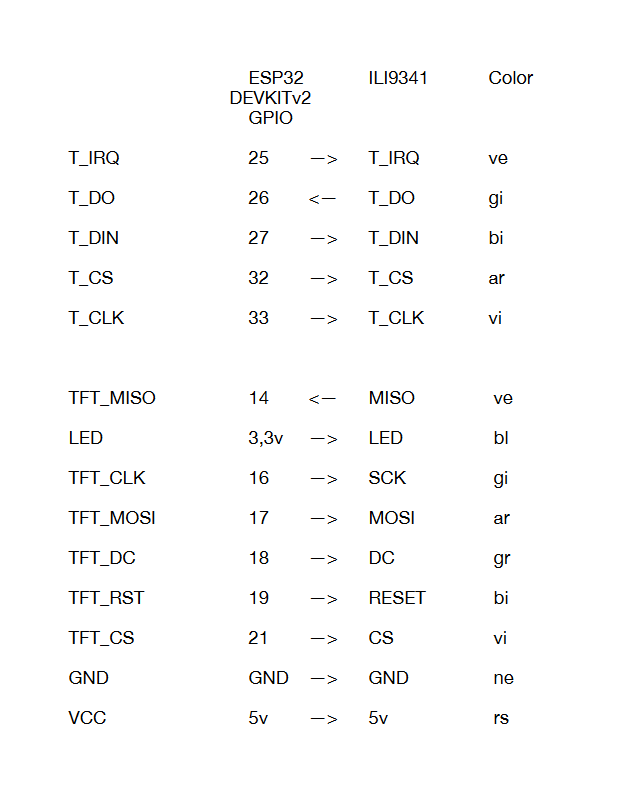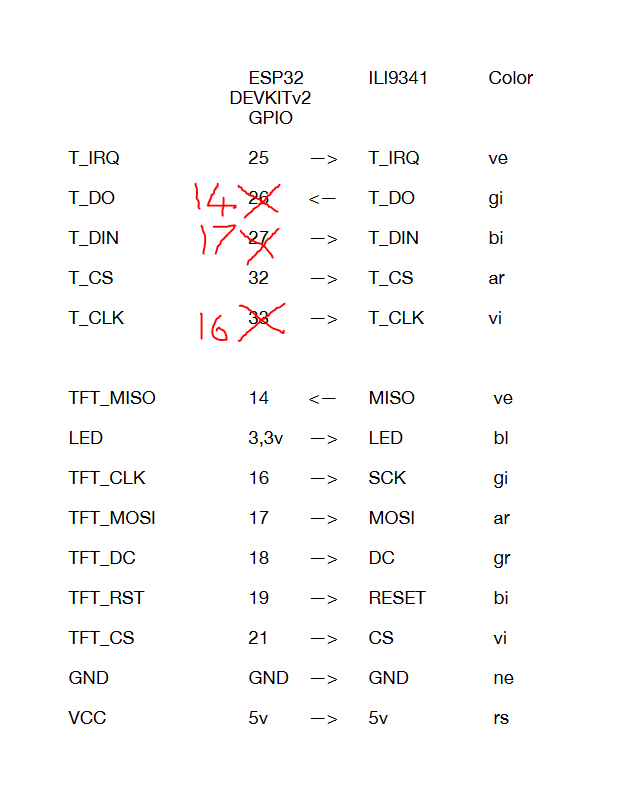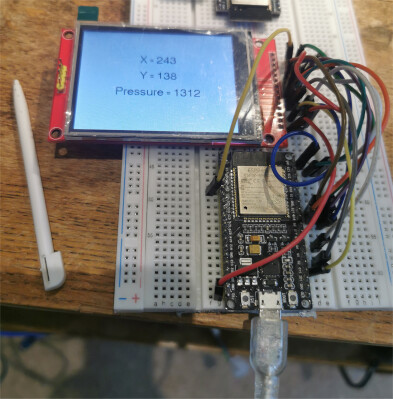using the XPT2046_Touchscreen library with the 2.8_ SPI TFT LCD Display Touch Panel ILI9341 I used the following code
Touch_Test.ino file
// TFT_eSPI touch test 240X320 Resolution 2.8_ SPI TFT LCD Display Touch Panel ILI9341
/* Rui Santos & Sara Santos - Random Nerd Tutorials
THIS EXAMPLE WAS TESTED WITH THE FOLLOWING HARDWARE:
1) ESP32-2432S028R 2.8 inch 240×320 also known as the Cheap Yellow Display (CYD): https://makeradvisor.com/tools/cyd-cheap-yellow-display-esp32-2432s028r/
SET UP INSTRUCTIONS: https://RandomNerdTutorials.com/cyd/
2) REGULAR ESP32 Dev Board + 2.8 inch 240x320 TFT Display: https://makeradvisor.com/tools/2-8-inch-ili9341-tft-240x320/ and https://makeradvisor.com/tools/esp32-dev-board-wi-fi-bluetooth/
SET UP INSTRUCTIONS: https://RandomNerdTutorials.com/esp32-tft/
Permission is hereby granted, free of charge, to any person obtaining a copy of this software and associated documentation files.
The above copyright notice and this permission notice shall be included in all copies or substantial portions of the Software.
*/
#include <SPI.h>
/* Install the "TFT_eSPI" library by Bodmer to interface with the TFT Display - https://github.com/Bodmer/TFT_eSPI
*** IMPORTANT: User_Setup.h available on the internet will probably NOT work with the examples available at Random Nerd Tutorials ***
*** YOU MUST USE THE User_Setup.h FILE PROVIDED IN THE LINK BELOW IN ORDER TO USE THE EXAMPLES FROM RANDOM NERD TUTORIALS ***
FULL INSTRUCTIONS AVAILABLE ON HOW CONFIGURE THE LIBRARY: https://RandomNerdTutorials.com/cyd/ or https://RandomNerdTutorials.com/esp32-tft/ */
#include <TFT_eSPI.h>
// Install the "XPT2046_Touchscreen" library by Paul Stoffregen to use the Touchscreen - https://github.com/PaulStoffregen/XPT2046_Touchscreen
// Note: this library doesn't require further configuration
#include <XPT2046_Touchscreen.h>
TFT_eSPI tft = TFT_eSPI();
// Touchscreen pins
#define XPT2046_IRQ 34 // T_IRQ
#define XPT2046_MOSI MOSI // GPIO23 // T_DIN
#define XPT2046_MISO MISO // GPIO19 // T_OUT
#define XPT2046_CLK SCK // GPIO18 // T_CLK
#define XPT2046_CS 5 // T_CS
SPIClass touchscreenSPI = SPIClass(VSPI);
XPT2046_Touchscreen touchscreen(XPT2046_CS, XPT2046_IRQ);
#define SCREEN_WIDTH 320
#define SCREEN_HEIGHT 240
#define FONT_SIZE 2
// Touchscreen coordinates: (x, y) and pressure (z)
int x, y, z;
// Print Touchscreen info about X, Y and Pressure (Z) on the Serial Monitor
void printTouchToSerial(int touchX, int touchY, int touchZ) {
Serial.print("X = ");
Serial.print(touchX);
Serial.print(" | Y = ");
Serial.print(touchY);
Serial.print(" | Pressure = ");
Serial.print(touchZ);
Serial.println();
}
// Print Touchscreen info about X, Y and Pressure (Z) on the TFT Display
void printTouchToDisplay(int touchX, int touchY, int touchZ) {
// Clear TFT screen
tft.fillScreen(TFT_WHITE);
tft.setTextColor(TFT_BLACK, TFT_WHITE);
int centerX = SCREEN_WIDTH / 2;
int textY = 80;
String tempText = "X = " + String(touchX);
tft.drawCentreString(tempText, centerX, textY, FONT_SIZE);
textY += 20;
tempText = "Y = " + String(touchY);
tft.drawCentreString(tempText, centerX, textY, FONT_SIZE);
textY += 20;
tempText = "Pressure = " + String(touchZ);
tft.drawCentreString(tempText, centerX, textY, FONT_SIZE);
}
void setup() {
Serial.begin(115200);
// Start the SPI for the touchscreen and init the touchscreen
touchscreenSPI.begin(XPT2046_CLK, XPT2046_MISO, XPT2046_MOSI, XPT2046_CS);
touchscreen.begin(touchscreenSPI);
// Set the Touchscreen rotation in landscape mode
// Note: in some displays, the touchscreen might be upside down, so you might need to set the rotation to 3: touchscreen.setRotation(3);
touchscreen.setRotation(1);
// Start the tft display
tft.init();
// Set the TFT display rotation in landscape mode
tft.setRotation(1);
// Clear the screen before writing to it
tft.fillScreen(TFT_WHITE);
tft.setTextColor(TFT_BLACK, TFT_WHITE);
// Set X and Y coordinates for center of display
int centerX = SCREEN_WIDTH / 2;
int centerY = SCREEN_HEIGHT / 2;
tft.drawCentreString("Hello, world!", centerX, 30, FONT_SIZE);
tft.drawCentreString("Touch screen to test", centerX, centerY, FONT_SIZE);
}
void loop() {
// Checks if Touchscreen was touched, and prints X, Y and Pressure (Z) info on the TFT display and Serial Monitor
if (touchscreen.tirqTouched() && touchscreen.touched()) {
// Get Touchscreen points
TS_Point p = touchscreen.getPoint();
// Calibrate Touchscreen points with map function to the correct width and height
x = map(p.x, 200, 3700, 1, SCREEN_WIDTH);
y = map(p.y, 240, 3800, 1, SCREEN_HEIGHT);
z = p.z;
printTouchToSerial(x, y, z);
printTouchToDisplay(x, y, z);
delay(100);
}
}
User_Setup.h file (place in same directory as above .ino file)
// TFT_eSPI User_Setup.h file 240X320 Resolution 2.8_ SPI TFT LCD Display Touch Panel ILI9341
#define USER_SETUP_INFO "User_Setup"
#define ILI9341_DRIVER
// For ST7735, ST7789 and ILI9341 ONLY, define the colour order IF the blue and red are swapped on your display
// Try ONE option at a time to find the correct colour order for your display
// #define TFT_RGB_ORDER TFT_RGB // Colour order Red-Green-Blue
// #define TFT_RGB_ORDER TFT_BGR // Colour order Blue-Green-Red
// For ST7789, ST7735, ILI9163 and GC9A01 ONLY, define the pixel width and height in portrait orientation
#define TFT_WIDTH 240 // ST7789 240 x 240 and 240 x 320
#define TFT_HEIGHT 320 // ST7789 240 x 320
// If colours are inverted (white shows as black) then uncomment one of the next
// 2 lines try both options, one of the options should correct the inversion.
// #define TFT_INVERSION_ON
// #define TFT_INVERSION_OFF
#define TFT_CS 15
#define TFT_MOSI MOSI
#define TFT_SCLK SCK
#define TFT_MISO MISO
#define TFT_DC 2
#define TFT_RST 4
#define LOAD_GLCD
#define LOAD_FONT2
#define LOAD_FONT4
#define LOAD_FONT6
#define LOAD_FONT7
#define LOAD_FONT8
#define LOAD_GFXFF
#define SMOOTH_FONT
#define SPI_FREQUENCY 10000000
#define SPI_TOUCH_FREQUENCY 2500000
serial monitor output
X = 301 | Y = 43 | Pressure = 403
X = 242 | Y = 25 | Pressure = 674
X = 67 | Y = 39 | Pressure = 977
X = 212 | Y = 59 | Pressure = 683
X = 76 | Y = 36 | Pressure = 1782
X = 64 | Y = 56 | Pressure = 1814
X = 44 | Y = 83 | Pressure = 1846
X = 34 | Y = 114 | Pressure = 2026
X = 45 | Y = 151 | Pressure = 2083
X = 48 | Y = 178 | Pressure = 2119
X = 74 | Y = 207 | Pressure = 2088
X = 136 | Y = 206 | Pressure = 1556
X = 191 | Y = 205 | Pressure = 1935
X = 227 | Y = 211 | Pressure = 1782
X = 279 | Y = 225 | Pressure = 1673
X = 301 | Y = 218 | Pressure = 1632
X = 302 | Y = 205 | Pressure = 1540
X = 303 | Y = 188 | Pressure = 1511
X = 307 | Y = 169 | Pressure = 1435
X = 272 | Y = 148 | Pressure = 1531
X = 203 | Y = 131 | Pressure = 1583
X = 165 | Y = 131 | Pressure = 1872
X = 136 | Y = 114 | Pressure = 2017
X = 111 | Y = 104 | Pressure = 2013
X = 106 | Y = 85 | Pressure = 2002
X = 154 | Y = 114 | Pressure = 1977
X = 199 | Y = 136 | Pressure = 1853
X = 231 | Y = 173 | Pressure = 1727
X = 268 | Y = 155 | Pressure = 1655
X = 290 | Y = 153 | Pressure = 1483
as the pen is moved around the panel the display values are updated




